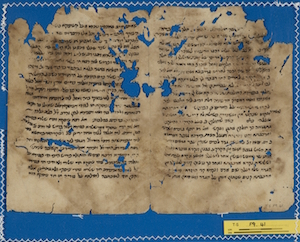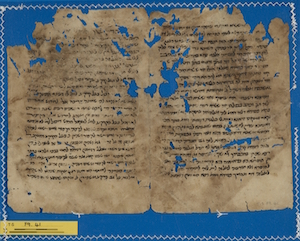Did the Jewish academies of Sura and Pumbedita hold original commentaries to the Talmud? T-S F9.41
By Zvi Stampfer
The fragment T-S F9.41 contains a commentary to the Babylonian Talmud, tractate Bava Meṣiʿa. The (unidentified) commentator inserted quotations from earlier sources in his explanation of various matters. When he reached the issue of ‘one venture divided into two contracts’ (BT Bava Meṣiʿa 104b: ‘Rava said: it is a loss for the lender when two contracts have been written for a venture. It is a loss for the borrower when one contract has been written for two ventures’), he quotes from Rabbi Alfasi’s 11th-century commentary and adds the following remark (the translation is my own):
He (Rabbi Alfasi) obtained the essence of his explanation from Rabbi Hayya’s commentary, who (in his turn) obtained it (and presented it) in the name of the First Ones (Rišonim). This is the text of Rabbi Hayya’s words, from the volume ‘The scholars of Nehardea said’, Responsum II.
Rav Haya ben Sherira served as the head of Pumbedita academy in Bagdad at the beginning of the 10th century. Although Alfasi does not mention Hayya’s commentary (not surprising, since he rarely indicates his sources), the author of the present text quotes Rabbi Hayya’s words and gives the exact reference for his source, ‘from the volume “The scholars of Nehardea said”, Responsum II’, a collection of queries and responses by Rabbi Hayya. The volume began with the words ‘The scholars of Nehardea said’, and this opening sentence therefore formed the title of the work. The author of the commentary probably assumed that his readers would be familiar with this work or at least have the ability to access this source, so the author references the name of the volume and the location of this particular responsum in the work – the second responsum. This bibliographical reference indicates that this quotation is accurate, authentic and well recognised.
With this remark in mind we now turn to the text. The author quotes Rav Hayya’s words (translation and emphasis mine):
This (Talmudic) statement of Rava is vague. He (Rava) did not explain in what way ‘it is a loss for the lender when two contracts have been written for a venture’, or ‘it is a loss for the borrower when one contract has been written for two ventures’, and we do not have any traditional (explanation of this statement). So the case should be written appropriately, if there is one venture then one contract [has to be written], and if there are two ventures then two contracts have to be written. In this way there is no loss to either party. But his (Rava’s) statement has not been interpreted to us, (i.e.) what will be the manner of loss. Hence, when our later rabbis studied (the topic) this is what occurred to them…
I have omitted the full explanation to avoid the necessity to delve into all of its minutiae, but after the explanation ends, the anonymous commentator adds the following sentence:
And he (i.e. Rabbi Hayya) said after it that we are not […] yet with this statement, except for the way which it has been told in the name of the eldest ones and that which is written in Pesuqot of Rabbi Yehudai.
Here, Rav Hayya gives us a unique insight into the study process of the Jewish academy and describes three different stages of commentary formation.
- The first stage is when the scholars of the academy look for previous traditional explanations of the Talmudic passages.
- The second stage is when the masters of the academy create an original explanation of their own.
- The third stage is when the original explanation of the Geonic scholars becomes an accepted written tradition.
Initially, the scholars of the academy did not know how to explain the Talmudic phrase. We can assume that the Jewish academies of Baghdad did not possess traditional explanations for certain parts of the Talmud, because we find many examples of disputes among them. However, this is a rare occasion in which Rabbi Hayya clearly says that the scholars did not possess any exegetical tradition regarding this Talmudic passage. It is even more striking since tractate Bava Meṣiʿa (in which the passage is located) had been part of the Geonic academy curriculum for as far back as we can trace, and the issues in this tractate are practical. Furthermore, this Talmudic passage deals with a very important and controversial issue in the changing economy following the Muslim conquest. Therefore, when Rabbi Hayya was asked regarding ‘the ʿiska’ – literally ‘venture’, a legal implement used to protect high-risk ventures of the sort that Jewish merchants engaged in following their incorporation into the wider Muslim world – he, rather surprisingly, answered that he had no tradition on this matter.
From this we can conclude that there were significant cases in which the central Jewish Academies of the Geonic period had received no authoritative tradition from the Talmudic period on the passages in the Talmud. This suggests that there was a disconnection and interruption between the time of the Talmud’s editing and the Geonic academies. This interruption probably occurred during the 6th century as Rav Sherira (Rabbi Hayya’s father) informs us in his epistle:
And there were years of persecution and troubles at the end of the Persian (i.e. Sasanian) monarchy and they were unable to establish public lectures and convene the academy… until a number of years had elapsed (Brody 1998: 8)
As Rabbi Hayya does not refer to the absences of tradition as a rare occasion, it seems that there were a number of other cases in which scholars had no suitable explanations for Talmudic passages.
In the second stage, the scholars of the academy tried to form their own explanations. Rabbi Hayya calls them ‘our later rabbis’. This label appears occasionally in Geonic literature. For example, one of the Geʾonim, probably Rabbi Hayya, wrote referring to the Šeʾiltot – a work of the beginning of the 8th century – ‘which was edited by our later Rabbis’. These ‘later Rabbis’ he refers to are the Geʾonim, the Jewish scholars of the 7th–8th centuries, a few decades before the compilation of Halaḵot Pesuqot.
In the third stage, the explanations of these ‘later Rabbis’ were transferred and studied in the academy until the days of Rabbi Hayya. The explanations became part of the extra Talmudic oral tradition and Rabbi Hayya offered this explanation as the best option he had.
The anonymous author of our fragment remarks that this internal tradition was fixed in the Pesuqot of Rav Yehudai. This remark is from the author as he uses the term ‘eldest one’ to refer to the scholars of the Geonic period.
Indeed this internal tradition that was carried down by Rabbi Hayya appears nearly word for word in Halaḵot Pesuqot. This supports the well-known fact (cf. Danzig 1993: 163–167; Morell 1982: 60–67, 90–92; Brody 1994: 146–147) that the author of Halaḵot Pesuqot was intimately familiar with the internal traditions of the academies.
Cambridge University Library T-S F9.41 recto: a commentary to Babylonian Talmud, Tractate Bava Meṣiʿa
Cambridge University Library T-S F9.41 verso: a commentary to Babylonian Talmud, Tractate Bava Meṣiʿa
Bibliography
Brody, Robert, מחקר ספרות ההלכות מתקופת הגאונים, Tarbiz 64 (1994).
–, The Geonim of Babylonia and the Shaping of Medieval Jewish Culture, New Haven and London: Yale University Press, 1998.
Danzig, Neil, Mavo le-Sefer Halakhot Pesukot ʿim Tashlum Halakhot Pesukot / Introduction to halakhot Pesuqot with a Supplement to Halakhot Pesuqot. New York and Jerusalem: The Jewish Theological Seminary of America, 1993 [Hebrew].
Morell, Shmuel, מקורותיו של ספר הלכות פסוקות, Proceedings of the American Academy for Jewish Research 49 (1982).
My research is generously supported by the Parasol Foundation

Cite this article
(2015). Did the Jewish academies of Sura and Pumbedita hold original commentaries to the Talmud? T-S F9.41. [Genizah Research Unit, Fragment of the Month, March 2015]. https://doi.org/10.17863/CAM.8235
If you enjoyed this Fragment of the Month, you can find others here.
Contact us: genizah@lib.cam.ac.uk
The zoomable images are produced using Cloud Zoom, a jQueryimage zoom plugin:
Cloud Zoom, Copyright (c) 2010, R Cecco, www.professorcloud.com
Licensed under the MIT License
- See more at: http://www.lib.cam.ac.uk/Taylor-Schechter/fotm/march-2015/index.html#sth...


